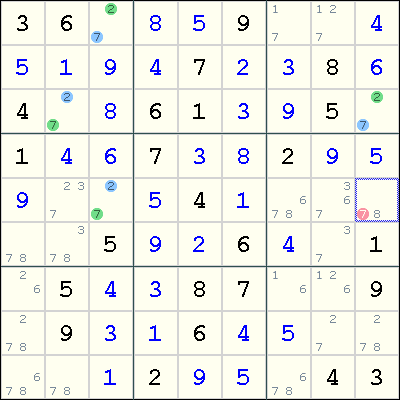Mirrored from Sudopedia, the Free Sudoku Reference Guide
Remote Pairs
The Remote Pairs technique uses a XY-Chain involving an even number of bivalue cells, and all the cells have the same two digits as their candidate. The chain can be seen as a series of Naked Pairs. Both digits may be eliminated from any cell that is seen by both ends of the chain.
In practice, Remote Pairs is rarely seen. However, when encountered, Remote Pairs is far more obvious than the typical XY-Chain, and possibly more obvious than a X-Chain or XY-Wing.
How it works
The technique uses the fact that due to the series of links, the entire chain must contain an alternating series of digits. By considering each pair of cells with opposite parity, except those directly linked, cells that can see both cells of such a pair cannot contain either of the two digits.
Here is a schematic example. The alternating digits are named X and Y.
|
|
| --
| --
| --
|
| --
| YX
| --
|
| --
| --
| XY
|
|
|
|
|
|
|
|
|
|
| --
| XY
| --
|
| YX
| --
| --
|
| --
| --
| --
|
|
Candidates X and Y are already removed from the cells marked with a dash because of the naked pairs. The cells marked with * are possible eliminations for the Remote Pairs technique as they see two pairs of opposite parity (indicated by the XY and YX ordering).
Example
This example comes from a possible solving path for Daily Nightmare of 2007 January 9.

A chain of bivalue cells containing the candidates 2 and 7 can be identified: r5c3 - r1c3 - r3c2 - r3c9. This results in the elimination of 7 from r5c9.
Other techniques
There is a strong overlap between Remote Pairs and other solving techniques. The same eliminations can be performed by the following alternatives:
External links
See also
This page was last modified 05:37, 17 January 2009.

